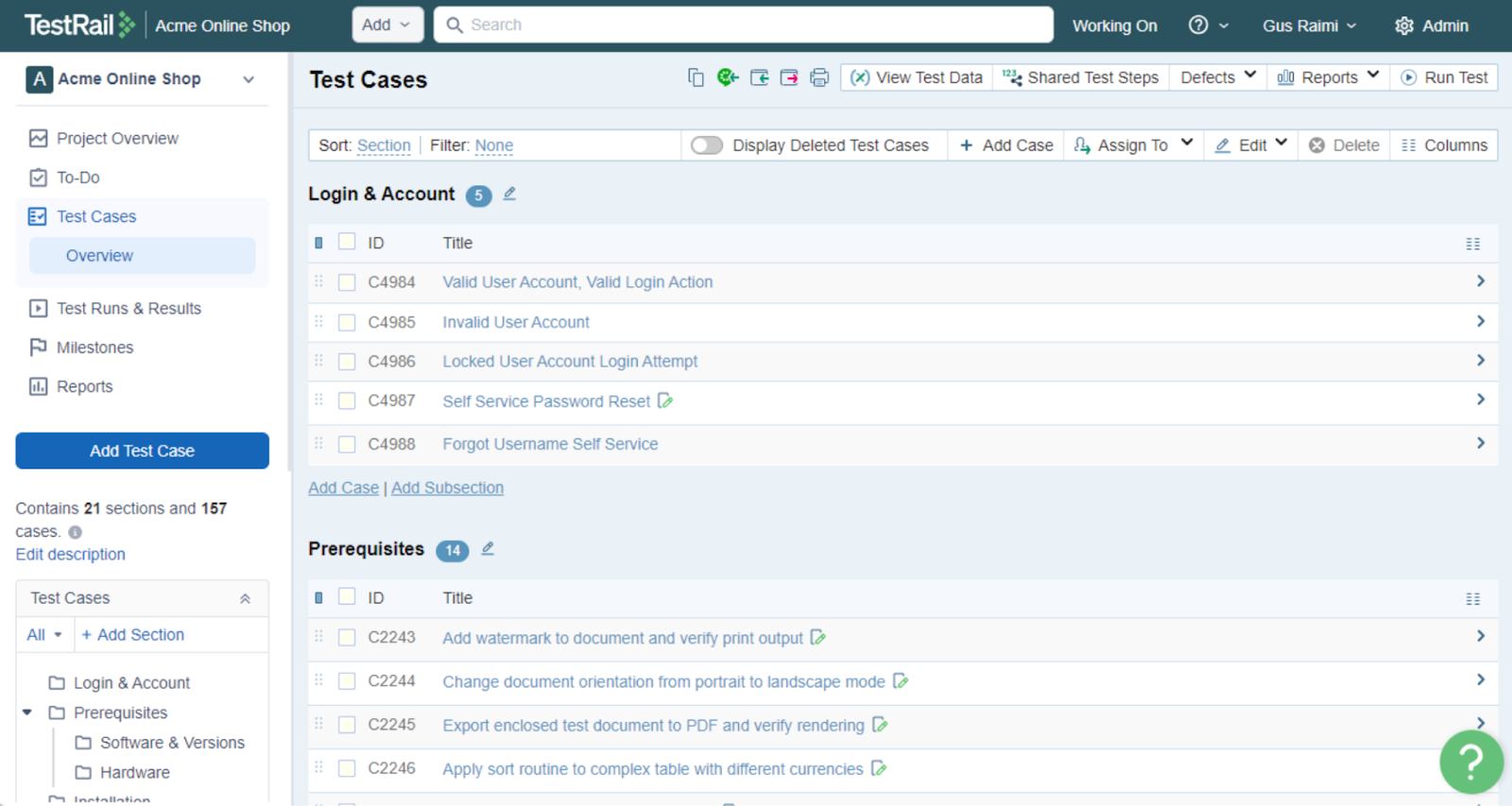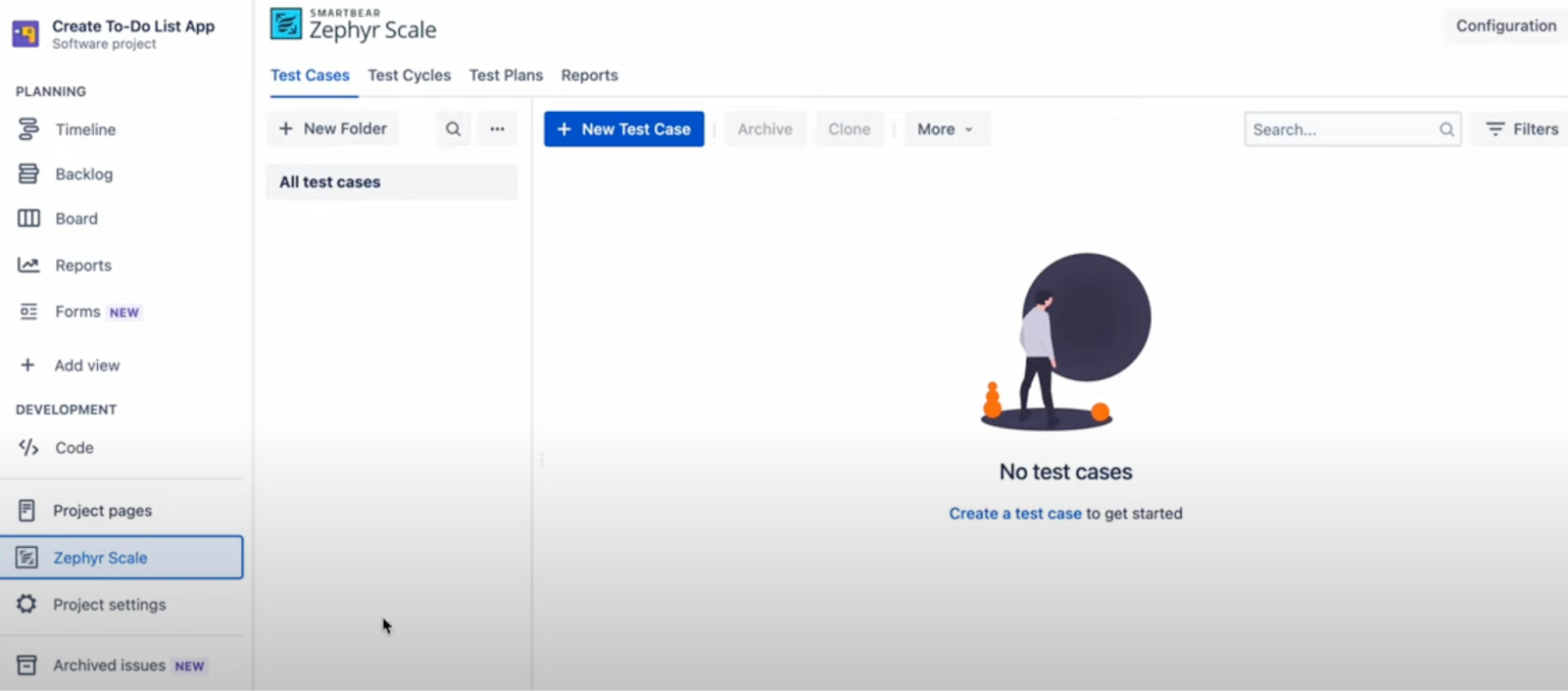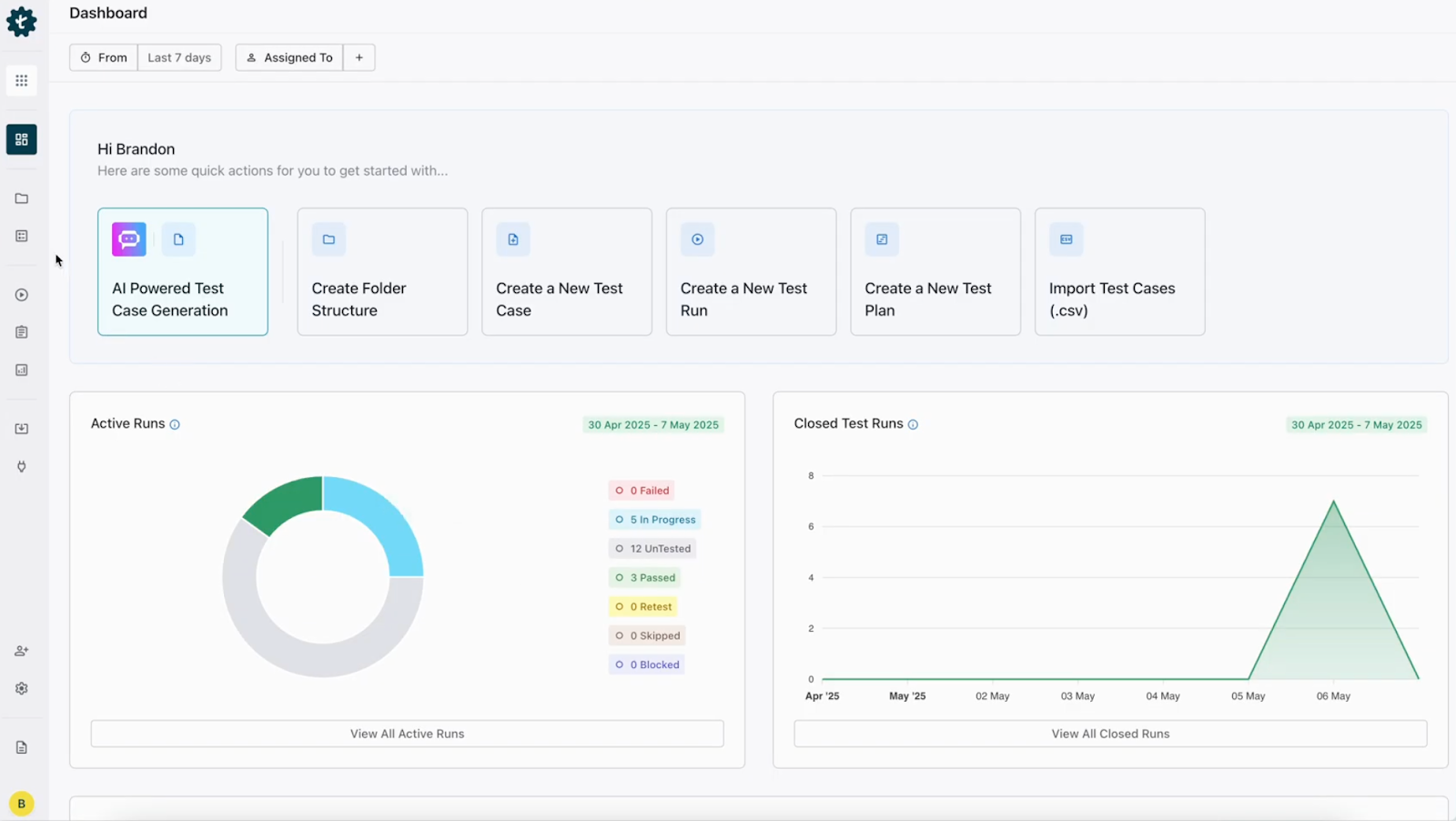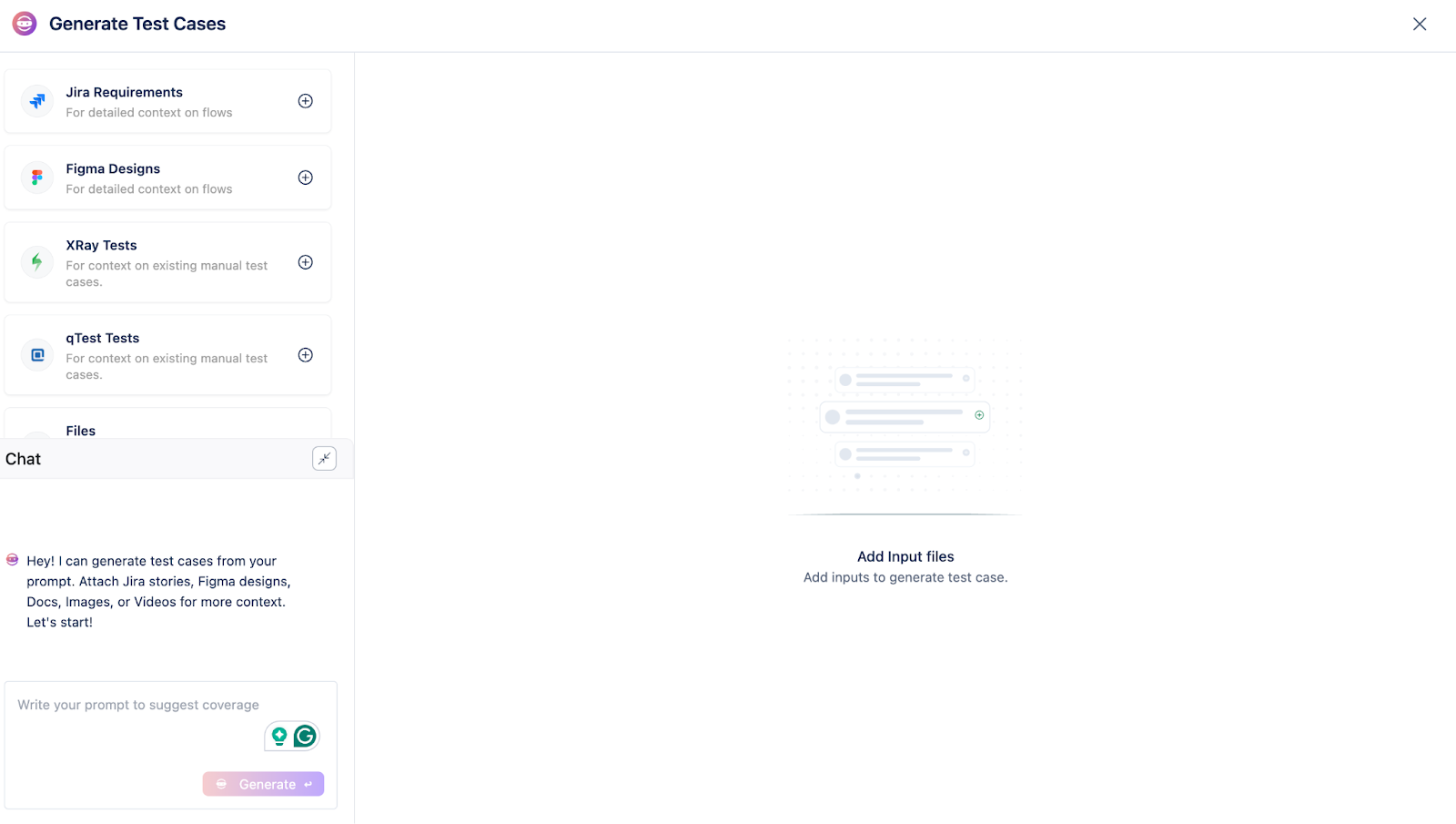Table Of Contents
- 1 Overview
- 2 Testrail vs Zephyr: An Overview
- 3 What is TestRail?
- 4 What is Zephyr?
- 5 Testrail vs Zephyr: Detailed Comparison of Features
- 6 Pricing Analysis
- 7 Performance & Scalability Comparison
- 8 User Experience & Interface
- 9 When to Choose TestRail vs Zephyr
- 10 Alternative to TestRail & Zephyr
- 11 Conclusion
- 12 FAQ’s
Overview
How are TestRail and Zephyr different?
TestRail is a standalone test management tool built for structured QA workflows, while Zephyr works inside Jira and keeps testing tightly connected to issues, sprints, and development activities.
When to choose TestRail and Zephyr?
Choose TestRail when you want detailed reporting, organized test repositories, and a dedicated QA environment. Choose Zephyr when your team works heavily in Jira and wants test management integrated directly into the development workflow.
Which is the best alternative to TestRail and Zephyr?
Test Management by Testsigma is a strong alternative because it combines a clean, modern interface with AI driven test management, real time insights, and seamless Jira integration, giving teams a more scalable and future ready option.
Teams often compare TestRail and Zephyr because both are widely used test management tools designed to support modern QA workflows. In this blog, you will find a clear overview of each tool, followed by a detailed TestRail vs Zephyr comparison across features, usability, and integrations.
TestRail Vs Zephyr: An Overview
Here is a quick overview before we dive deeper into each tool.
What is TestRail?
TestRail is a dedicated test management software that helps QA teams plan, track, and organize testing activities in a centralized workspace. It provides a structured setup for designing test cases, executing test cycles, tracking results, and generating detailed reports.
Key Capabilities:
What is Zephyr?
Zephyr is a test management solution designed for agile and DevOps teams, available as a native test management layer inside Jira and in standalone enterprise editions. It helps teams create test cases, organize test cycles, execute tests, and track progress alongside development tasks.
Key Capabilities:
TestRail Vs Zephyr: Detailed Comparison of Features
| Criteria | TestRail | Zephyr |
| Core functionalities | Structured test case management with suites, milestones, and detailed planning | End-to-end test management within Jira or a standalone enterprise version |
| Test case management | Robust test case creation, organization, reuse, and versioning | Test case design and organization built around Jira projects and agile workflows |
| Test execution and scheduling | Allows planning, scheduling, and running test cycles with assignments and progress tracking | Test cycles and test executions integrated with Jira sprints and releases |
| Defect management | No built-in defect module, relies on integrations like Jira | Built-in defect tracking when used with Jira issues |
| Reporting and dashboards | Extensive customizable reports and real-time dashboards | Dashboard gadgets and reports aligned with Jira reporting features |
| Tool integration | Integrates with Jira, GitHub, GitLab, Jenkins, and other CI/CD tools | Strong Jira native integration plus CI/CD and automation tool support |
| Automation integration | API based integration for automation result push and reporting | Automation frameworks can push results into Jira through Zephyr APIs |
| Requirement traceability | Links test cases to requirements and milestones | Full requirement linking through Jira stories, epics, and tasks |
| Intuitive user interface | Dedicated, clean UI optimized for structured test management | Familiar Jira-based interface, especially for teams already using Jira |
| Collaboration tools | User roles, permissions, and project-level access controls | Collaboration and permissions handled through Jira’s native model |
| Scalability | Suitable for small to enterprise-level testing with large repositories | Scales based on Jira instances or enterprise edition capabilities |
| Support and training | Documentation, community resources, and enterprise support | Documentation, Atlassian marketplace resources, and enterprise support |
Learn test management in detail!
Pricing Analysis
Testrail
TestRail offers two cloud plans and an on premise option, each priced per user or per license depending on the deployment model. The Professional Cloud plan costs $37 per user per month or $ 420 per user annually, while the Enterprise Cloud plan costs $74 per user per month or $852 per user annually, and includes advanced security, administrative controls, and priority support. Cloud customers can choose monthly or annual billing, with annual billing providing better value.
For teams that prefer self-hosting, TestRail’s on-premises server licenses require a minimum of 10 users. A 10-user Professional Server license costs about $8,140 per year, while a 10-user Enterprise Server license costs about $16,500 per year and includes enterprise-level capabilities. Additional services such as concierge support and enhanced backup options can be purchased separately, making the enterprise plans more expensive but better suited for large teams that need stronger control, security, and administrative flexibility.
Zephyr
Zephyr Squad, the Jira-integrated edition, starts at a low monthly price per instance. Additionally, a higher-tier option, priced around $30 per month, includes expanded test automation and parallel testing features. These prices are visible on the Atlassian Marketplace, making them easy for teams already using Jira to evaluate.
For Zephyr Enterprise, which is the standalone version outside Jira, pricing is not publicly listed. SmartBear provides quotes only through its sales team, so organizations must request custom pricing based on their size, deployment needs, and feature requirements.
Performance & Scalability Comparison
TestRail generally delivers faster and more consistent performance, especially when handling large test suites, bulk edits, or heavy reporting. Its standalone architecture reduces load on external systems, which helps it stay responsive even as test data grows. Zephyr, being tightly coupled with Jira, can slow down when Jira projects become large or when multiple teams share the same instance, leading to delays in loading test cycles, executing searches, or managing attachments.
When it comes to scalability, TestRail extends this performance advantage by supporting bigger repositories and offering flexible deployment options that grow with enterprise needs. Zephyr’s scalability is limited by the underlying Jira environment, which can become a bottleneck as teams expand or test volumes increase. This makes TestRail the more reliable long-term choice for enterprises that need consistent speed and smooth scaling as their QA operations mature.
Both TestRail and Zephyr lack advanced agentic AI-based test management features that modern QA teams now rely on to move faster. Platforms like Test Management by Testsigma offer these capabilities with intelligent planning, automated updates, and real-time insights. This is why many enterprise teams outgrow TestRail and Zephyr and switch to agentic AI-driven test management, which you can try with a free trial starting today.
User Experience & Interface

TestRail’s user experience is generally praised for its clean, structured interface, which makes organizing test suites, cases, and runs straightforward for both testers and managers. Many users find the navigation and reporting intuitive, with quick access to filters, tags, and reusable templates, though there is a modest learning curve for power features and occasional complaints about handling very large repositories.

Zephyr’s user experience is strongest when teams are already embedded in Jira because the UI feels familiar and keeps requirements, issues, and tests in one place. Users appreciate the convenience of staying in Jira, but some report that test editing and large test plans can feel clunky and that performance depends on Jira’s tuning, which can affect responsiveness as projects grow. For Jira-centric teams, the integrated experience is a clear benefit, but it can be less smooth for heavy test management tasks compared with a dedicated test management UI.

Test Management by Testsigma offers a far more modern and intuitive UI compared with both TestRail and Zephyr. The interface makes AI Agents, AI co-worker capabilities, and other intelligent features easy to access directly in the workflow. It is simple to track what passed, failed, and why, with clear insights into root causes. With its two-way Jira integration, managing and syncing test cases inside Jira becomes seamless for teams.
When to Choose TestRail Vs Zephyr
Here’s a clear, practical list of scenarios to help teams decide when to choose TestRail and when to choose Zephyr.
When to Choose TestRail
When to Choose Zephyr
Here’s what a tester on Reddit has to say about Zephyr:

TestRail also seems not too different. Here’s a review from a TestRail user:

What is available in Zephyr is not found in TestRail and vice versa, but modern agile teams deserve access to all these capabilities in one place. Test Management by Testsigma brings these strengths together by offering structured test planning, seamless two-way Jira integration, and deep alignment with agile workflows. It supports large, complex test repositories, delivers powerful analytics, and enhances every stage of testing with AI Agents and an AI co-worker. With a clean interface and scalable architecture, it provides everything teams need to manage, execute, and optimize testing in a single unified platform.
Alternative to TestRail & Zephyr
Test Management by Testsigma is a modern, agentic AI-powered test management tool that helps teams plan, track, and manage all their testing in one place. It brings manual, automated, and exploratory testing together and makes everyday QA work easier with AI Agents and an AI coworker called Atto that assists with test creation, execution, and reporting. With clean dashboards, simple workflows, and two-way Jira integration, teams gain full visibility into requirements, test runs, and defects without needing to switch between tools. It’s built for fast-moving agile teams that want a smarter and more efficient way to manage testing.
Key Features of Test Management by Testsigma
Unlike TestRail or Zephyr, Testsigma gives you an AI coworker called Atto, which uses different agents to plan sprints, write test cases, run tests, and report bugs automatically.

You can manage manual, automated, and exploratory tests all under one roof, unlike when you use separate tools or integrations. It supports organizing test cases, filtering, and version control so teams can reuse steps and keep things clean.
Changes in Jira (stories, statuses) are reflected in Test Management by Testsigma, and vice versa, and this gives you full traceability without switching between tools. Requirements, test results, and bug reports remain aligned in real time.
Test Management by Testsigma lets you run tests on real browsers, devices, or environments, and supports parallel execution too. Its AI agents adapt tests if the UI or API changes, so you spend less time fixing broken tests, a big advantage over traditional tools.
You get customizable dashboards that highlight execution trends, test coverage, and recent activity, helping you make data-driven decisions. Real-time insights let you quickly spot failures, flaky tests, or coverage gaps.
Testsigma integrates with more than 30 tools, including Jira, CI/CD platforms like GitHub, GitLab, Jenkins, and more. It fits into your existing tech stack without disrupting your current workflow.
Team members can comment, leave feedback, and collaborate within the tests platform, not just in a disconnected spreadsheet. Role-based access control helps you set who can create, edit, or run tests.
You can try Testsigma for free with a 7-day trial, and there’s a forever-free plan for smaller teams or basic test management needs. Paid plans are accessible and designed to scale as your team grows.
Why This Matters Compared to TestRail and Zephyr?
Conclusion
Choosing between TestRail and Zephyr comes down to how your team works and what you value most in a test management system. TestRail suits teams that need a structured, standalone platform with strong reporting, while Zephyr works best for teams that live inside Jira and want everything in one ecosystem. Both tools cover the essentials, but they also come with limitations that modern QA teams may outgrow. If you’re looking for a more flexible, AI-driven, and scalable way to manage testing, exploring newer solutions like Test Management by Testsigma can offer a more future-ready experience. Try agentic test management; start right away with a free trial.
FAQ’s
Not necessarily. It depends on what your team needs. TestRail works better as a standalone, structured test management tool with strong reporting, while Zephyr is more useful for teams that work entirely inside Jira and want testing connected directly to issues and agile workflows.
The main difference is that TestRail is an independent test management system built specifically for QA, whereas Zephyr functions inside the Jira ecosystem and keeps test cases, issues, and sprints together in one place.
Yes, you can migrate from Zephyr Scale to TestRail by exporting test cases in Excel or CSV format and importing them into TestRail. Some items, like attachments, custom fields, or detailed execution history, may not transfer perfectly and may require manual adjustments.
Zephyr is generally more cost-effective for smaller teams because its Jira-based editions have lower entry pricing. TestRail tends to be more expensive per user, but it offersa stronger structure and reporting that some teams find valuable.
Yes, both tools support automation testing through integrations. TestRail allows automation results to be pushed in through APIs and CI tools, and Zephyr supports automation through its API and CI integrations to upload results from common test frameworks.


